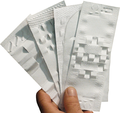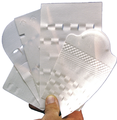- Cleaning cards
-
A cleaning card is a product designed to clean a device that facilitates a transaction. In order for the cleaning card to work properly in the device, it is important that the card resembles or mimics the material of the transaction media, in other words looks like a credit card or currency. As the cleaning card is inserted and passed through the device, it will clean components that would normally come in contact with the transaction media. Except for the cleaning of chip reading contacts in card readers. Here no friction is created between the inserted cleaning card and the chip reading contacts because after the lowering of these contacts the cleaning card stand still. So it's manadatory to produce friction for the cleaning otherwise.A typical cleaning card is much like a wiper that can get into areas that are not readily accessible. Typically, the cleaning card has a solid core covered by a soft wipe-like material. The product is then saturated with the correct cleaning solution recommended by the device manufacturer and then placed in a sealed pouch to maintain the saturation level and cleanliness of the card.
Contents
History
The first commercial manufacturer of cleaning cards for transaction devices was Head Computer Products (Clean Team Company) founded in 1981 by Stan Eyler in Los Angeles, CA. Head Computer Products was manufacturing a patented colored Cleaning Diskette for floppy Disk Drives and created dozens of different types of Cleaning Cards and Cleaning Sheets (for facsimile machines, copiers, printers). Some Cleaning Cards were colored, others changed color, some had material that reached up and cleaned normally unaccesible areas, some were presaturated and some worked with a unique dry material that felt wet to the touch.[citation needed] Clean Team, also founded by Eyler as an original developer and manufacturer holds a number of Eyler's US Patents (see Patents) and was the largest manufacturer of Cleaning Cards in the world. In 1992, KIC Products was founded by an ex-employee of Clean Team and distributed similar cleaning cards on the east coast. In September 2004, KIC Products launched a new style of cleaning card called Waffletechnology which is a patent -pending product. In June 2008 both KIC Products and Clean Team merged to become the largest manufacturer of cleaning cards, KICTeam, Inc., maintaining offices in the United States, Canada, Singapore and the United Kingdom.
Evolution
The cleaning card has evolved with the equipment they need to clean. A perfect example is the bill acceptor. Initially, the bill acceptor was designed as a means of selling candy to the public. The device needed to recognize that a US one dollar bank note had been inserted. The cleaning card was required to be the same shape as US currency in order to be accepted into the device to clean it. Vending machines began accepting higher denominations as well as having the ability to make change. Specialized sensors were introduced into the bill acceptor to recognize multiple denominations and to only accept media that contained bank note characteristics. The bill acceptor cleaning card was invented by Eyler and developed to contain bank notes characteristics so as to be accepted by the equipment. The development of bill acceptors by JCM for the slot machines in the gaming and casino industry, required the bill acceptor to be more sophisticated. The JCM bill validators needed to validate currency of multiple denominations up to a one hundred dollar bank note. Fraud was now a critical issue and was addressed by multiple sensors and optics throughout the inserted currency pathway. These sensors and optics were recessed so as to keep currency from running across them with each insertion and wearing down sensitive lenses. The cleaning card incorporating Waffletechnology was developed to be able to wipe clean these sensitive recessed areas without harming the device.
Patents
Notable US Patents on cleaning cards 5824611, D420658, D410457, 5832566, 5824611, 5525417, 5227226. Some of Eyler's patents are held in other's names.
What is a transaction?
Transactions are any action that has a monetary implication or transfer information from one media to another. The most commonly thought of transactions are the use of credit or debit cards through a POS Terminal or ATM of some type. Card readers are also widely used for hotel door Keycard locks or Access control devices. Another of the most common is a currency transaction via vending, gaming slot machines, or Self checkout kiosk where a bill acceptor takes your currency or a currency counter tabulates quantity. Many printers are transaction devices such as cashless ticket printers in the gaming industry. Barcode Printers and Thermal printers that print receipts, barcode labels, airline bag tags and many others transfer information either visually or through computers.
Gallery
See also
- Slot Machine
- Check 21 Act
- Currency detector
References
Categories:- Solid-state computer storage media
- Cleaning tools
Wikimedia Foundation. 2010.


